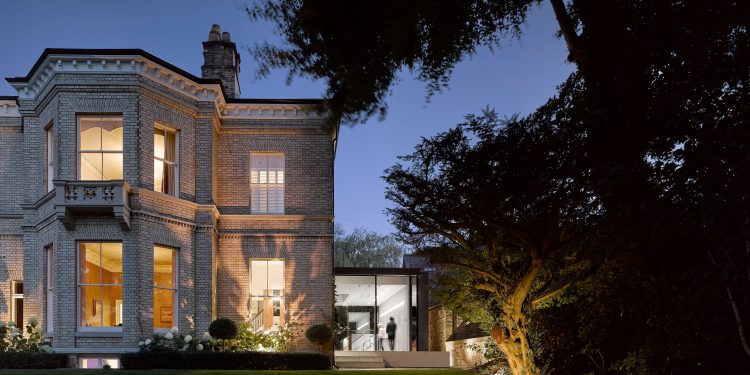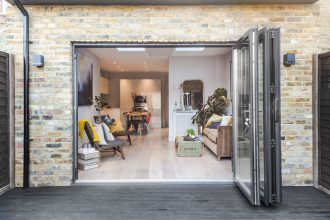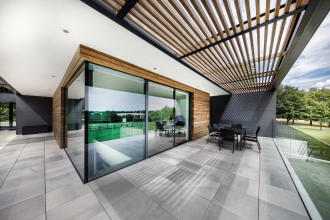Frog Castle

Frog Castle is a grand period property, built in 1860 and situated in the heart of Alderley Edge, Cheshire. The clients’ brief was to create additional living space in the form of a contemporary extension, including remodelling parts of the existing house and a basement conversion. The basement now accommodates a games room, cinema room, wine room and ancillary spaces.
The original house, both inside and out, has many stunning period features, so any intervention had to be given the utmost detailed consideration. The clients were keen for the interiors to seamlessly coordinate with the architecture, and as such, appointed Scott Donald Architecture (SDA) for interior design. It was clear from the start of the relationship that the clients had a keen eye for detail, and given our passion and drive for detail design, SDA relished the opportunity.
The clients’ aspiration for the extension was essentially a glass box. They were keen for the extension to contrast with the solid, brick aesthetic of the original house and for it to take advantage of the private gardens, both front and rear. This was achieved by an ‘open-ended’ concept, with tall (3.2m) sliding walls of glass to both ends. Rooflights over the glazing creates additional drama and allows light to penetrate throughout the day. A ‘structureless’ corner and pocket sliding glass doors creates an expansive opening to the rear garden. The clients were also keen to make a feature of the stone wall which ran along the boundary of the site. It was important that the interior spaces could see and ‘interact’ with this stone wall.
Though there was some heavy structural intervention to achieve the design, it was crucial that the extension respected the original house. Thus, the new extension sits against the gable of the house, but does not detract from it’s grand presence – it is subservient and respectful of the original house (images 01 – 05) It is this same concept that was applied to the interior design when dealing with the transition of original and new spaces. Considered attention was paid to allow a smooth, almost unnoticed, flow from traditional period into contemporary. (images 06 & 07. Image 06 shows the view back to original entrance hall and captures the 3 staircases to the house. Floor finishes, architrave / skirting details and lighting were some of the elements considered in this ‘ transition’. Image 07 demonstrates how the back stair was preserved in character, yet sits comfortably within the contemporary space of the rear entrance hall – image 13.)
Though the interior style is undoubtedly contemporary and somewhat minimal, SDA were keen not to compromise on practicality. This was achieved through clever design of hidden storage throughout the house. The rear entrance hall (image 13) was designed to contain storage behind the wall. The same wall has a hidden door to wc which allows the space to be open to the hall, providing additional light and views to the garden whilst maintaining the clean lines of the adjacent oak feature wall.
Similarly, in the dining space (image 11), SDA designed a bespoke feature storage wall with feature display recesses. The back panels of these recesses are pitted bronze, which create an interesting feature when lit from above. This custom-designed storage wall defines the dining area.
A key part of the interior design was the ability for the clients to display their art collection. The clean, contemporary interiors are enlivened by their art with the blocks of colour and texture. To the kitchen (images 06 & 08), a block of dark red art was commissioned to contrast with the whites and greys. Similarly, a black / blue textured piece of art was chosen for the rear entrance (image 13) to greet one on entering the house – the 10mm shadow gap around the head of the doors creates a frame for this art piece. These wall positions were identified at a very early stage of the interior design.
A feature of the kitchen space is the position of the new stair down to the converted basement. It was designed to add drama to the kitchen and rear entrance hall (Image 06 & 12), and significantly, the clients were keen for the basement to become a key floor of the house – all family members using the basement have to circulate past the kitchen, promoting interaction. From the bottom of the stair, the glass rooflight floods light deep into the basement and provides a view to the sky and tree canopies (Image 15). The attention to detail on the interior design is evident on the stair handrail detail. It was very important to SDA that one read the handrail descend as a clean line without any visible support bracket. At ground floor, it is supported via a hidden baseplate, and as it emerges through the stone floor, it was set-out to line through with the tile joint and glazing mullion, thus avoid a cut tile. (image 14). It is this rigorous attention to detail that has been applied to the interior design throughout the project.
Perhaps the most considered element of the project was the kitchen. The clients were very keen to have a unique kitchen that would not be seen anywhere else, so a bespoke designed kitchen was the solution. SDA had the responsibility of designing the kitchen, from space-planning through to interiors of utensil drawers. A specialist furniture-maker was appointed to build.
Though the finished result is sleek and contemporary, there was significant detailed input required to achieve this. For example, picking up the clients original desire to see the stone wall from inside, SDA proposed to frame a view of the wall through the kitchen – the wall would be lit at night to create an interesting feature. It was paramount that the appliances sat to the right of this frame, completing a simple rectangle. (image 09). To achieve this, consideration was given to the height of the appliances, worktop height, underside of wall units (in order there was sufficient headroom) and interfaces of marble top with lacquered reveals. The end result is a simple, framed view of the stone wall, but this was the outcome of many design deliberations.
Similar to the concept of the dining storage wall, the clients were keen to maximise storage and practicality. As such, SDA designed a pantry area so items like toaster, cereal boxes etc can be easily accessible, yet hidden away to maintain the clean block aesthetic. (images 16 & 17)
The kitchen island was designed to contrast the white bank. Statuario marble and tineo-veneered door fronts create a richer aesthetic and allow the island to take pride of place in the centre of the new extension.
SDA believes this kitchen demonstrates our skills in interior design and detailing. Only through this and our close relationship with the clients were we able to deliver a unique, statement kitchen which sits effortlessly in context with the rest of the house.
Client testimonial:
It was absolutely right that SDA take charge of the interior design of our project. The simplicity of the design does belie the underlying construction. The attention to detail was and is astonishing.
SDA were fastidious in ensuring that the fixtures and finishes sat perfectly within the spaces, from the perfect layout of the kitchen floor to the framing of the kitchen and dining space cabinetry and the scale of our island. We trusted SDA to get all of the details right. We were concerned about the scale of the island on paper. We now see it was absolutely right for the space.
I remember SDA telling us that design is about creating social spaces. The spaces we now have in our glass box and basement have brought our beautiful Victorian home up to date and given us an uplifting environment full of interest and texture where we all (teenage children included) socialise and entertain.


